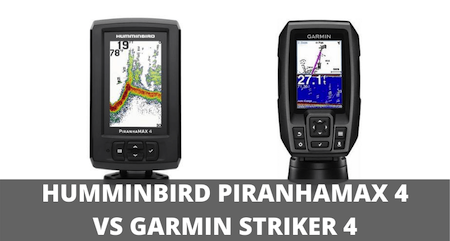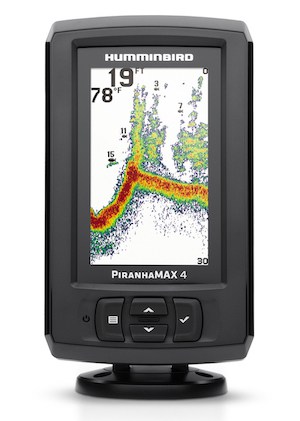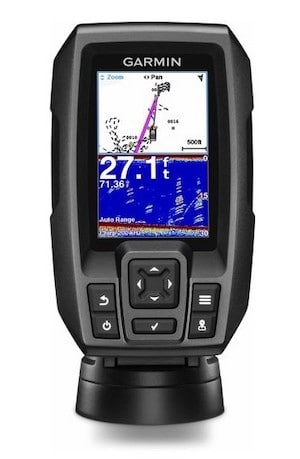Humminbird Piranhamax 4 Or Garmin Striker 4 – Which One Is Better?
UPDATED 14 MAY 2023
by Robert Ceran
This article may contain affiliate links. If you make a purchase after clicking on a link we may earn a small commission at no extra cost to you.
The Humminbird Piranhamax 4 and Garmin Striker 4 fish finders are popular entry level models from two of the best companies currently producing fishing electronics.
These two models retail at an almost identical price point just above $100, and are both designed to provide basic fish finder capabilities at an affordable price.
So what are their differences, and which one is better value for money?
My team and I tested the Humminbird Piranhamax 4 vs Garmin Striker 4 and compared them side by side. We’ll walk you through our findings and their most important differences, to help you choose the best model for your purposes.

Humminbird Piranhamax 4 vs Garmin Striker 4 compared side by side
In the table above we compare the most important specifications and features of the two fish finder models that we tested.
As you can see, they are broadly similar, but there are significant differences when you dive into the details.
Now let’s dive into the details and look at the main differences between the two models that were revealed by our testing.
The most important differences between the Humminbird Piranhamax 4 and Garmin Striker 4
Display size: With 4.3” diagonal, the Piranhamax 4 has a larger screen than the Stiker 4, which has a 3.5” diagonal. If screen size is important to you, then this point definitely goes to the Humminbird model.
Bottom line: Our testing showed that the Piranhamax 4 has a more generous screen size, which makes it easier to read the screen.
Screen resolution: The Striker 4 has a slightly better resolution, with 300 x 480 pixels, compared to 272 x 480 pixels. However, this difference is hardly noticeable, and shouldn’t make a difference in most cases.
Split screen functionality: While the Striker unit has a split screen functionality, the Piranhamax unit does not.
This makes a big difference, since our testing showed that you need the split screen on the Striker to look at GPS waypoints and sonar signals at the same time, or to zoom in one part of the screen, while looking at the bigger picture on the other part.
As fish finders have become more and more sophisticated over the past decade or so, split screen functionality helps a lot to take full advantage of all their features at the same time.
Bottom line: When we put them to the test, we found that the Striker 4 has split screen functionality, which is extremely useful to make use of several features side by side, while the Piranhamax 4 does not.
Dual beam sonar: Both units are identical in this regard, and come with dual beam sonar. Essentially, this means the transducer sends out two pulses at the same time, one narrow and focused, and one broader with less detail.
Sonar frequencies: This is another category with big differences between the two units. The Piranhamax comes with 200 & 455 kHz, while the Striker comes with 50, 77 & 200 kHz. 200 kHz is ideal for freshwater fishing in rivers and lakes.
The lower frequencies are useful for fishing in deeper water, and so come in handy for inshore fishing.
Bottom line: When we tested them, we found that both units have 200 kHz sonar, which is ideal for most freshwater fishing applications. In addition, the Striker 4 has 50 and 77 kHz sonar, which is useful for fishing in deeper inshore waters.
CHIRP sonar: The Striker 4 comes with a Garmin CHIRP transducer, which improves signal resolution and results in a higher level of detail and clarity.
In contrast, the Piranhamax 4 only has regular sonar.
Bottom line: Based on our testing, the Striker 4 provides higher quality sonar performance due to its CHIRP technology.
Maximum depth: The Striker 4 has a significantly greater depth of 1,600 feet, compared to the 600 feet of the Piranhamax 4.
This is due to the lower frequency wavelengths, which penetrate better into deeper water.
Fish ID technology: Both models are identical in this regard. With Fish ID you can essentially let the fish finder decide which signals are fish, and label them as such on your screen, which is a great feature for beginners.
Temperature sensor: Both units are identical in this regard, and come with a transducer with a temperature sensor.
Speed sensor: While the Striker 4 measures speed, the Piranhamax 4 does not.
This feature is especially useful for trolling, if you want to make sure you’re trolling at the correct speed.
GPS: This is another area with a major difference. While the Striker 4 has a GPS receiver that you can use for navigation, as well as placing waypoints, the Piranhamax 4 does not.
This is a big deal, since placing waypoints allows you to find your way back to specific locations quickly and easily.
Bottom line: During out testing we found that the Striker 4 has a GPS receiver that can be used for navigation and for placing waypoints, while the Piranhamax does not.
Now let’s look at each of the two units in more detail.
Humminbird Piranhamax 4


This is the most affordable Humminbird entry level fish finder. It’s designed to provide the most basic sonar capabilities without any bells and whistles.
One of its best features is the generous 4.3” display, which allows you to see details more easily.
In addition to Fish-ID technology, it also has several alarm features that can be very useful. For example, you can set an alarm for when it detects fish, or a change in depth.
Our testing revealed that the great thing about the Humminbrid Piranhamax 4 DI model is that it gives you access to the high quality of Humminbird down imaging sonar for less than 150 dollars, which is an awesome deal.

Features:
- 4.4” color TFT display
- Transom mounted transducer
- 2.5” target separation
Garmin Striker 4


This unit has consistently been the most popular entry level fish finder for many years, and continues to outperform other models in its category.
Not only does it pack surprisingly powerful sonar capabilities that can handle a maximum water depth of up 1600 feet, it also comes with CHIRP sonar, which was unheard of in the 100 dollar fish finder class until recently.
If you add to this the GPS functionality with waypoint mapping, and combine it with the split screen functionality of this Striker 4, our testing showed that this unit provides highly impressive mapping and sonar functionalities that are not usually found in this price category.

Features:
- CHIRP transducer
- GPS functionality with waypoint mapping
- Speed sensor
- Built-in flasher functionality
Conclusion
While both models reviewed here are high quality entry level fish finders, our testing revealed that the Garmin Striker 4 wins the contest, as it provides both higher quality sonar imaging (with its CHIRP transducer), as well as powerful additional features that are lacking in the Piranhamax 4.
These features include: GPS with waypoint mapping, split screen functionality, and speed measurement.
In our opinion, this makes it the best $100 fish finder currently on the market.
Gear and methods used for testing
For consistent testing results, we tested both fish finders on the same day on Lake Tarpon, to ensure we could compare their performance under similar conditions side by side. We performed testing by imaging schools of bluegill, crappie, and bass relating to structure in 6 to 21 feet of water.


